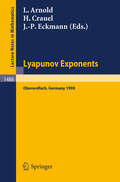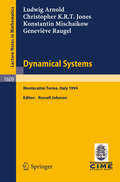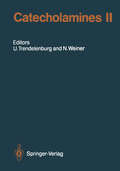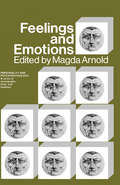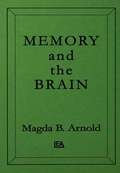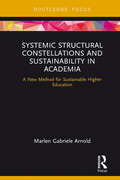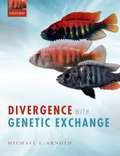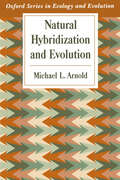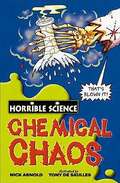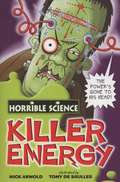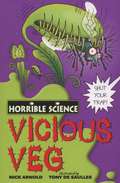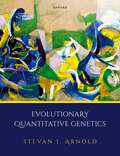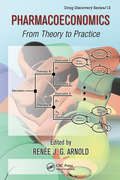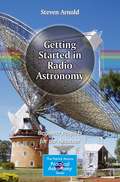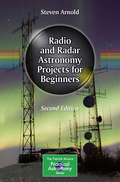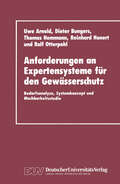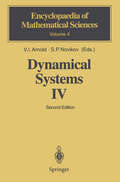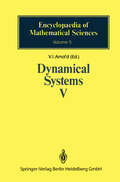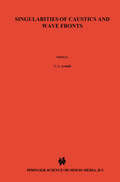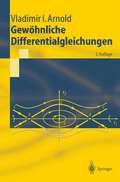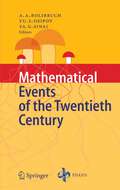- Table View
- List View
Lyapunov Exponents: Proceedings of a Conference held in Oberwolfach, May 28 - June 2, 1990 (Lecture Notes in Mathematics #1486)
by Ludwig Arnold Hans Crauel Jean-Pierre EckmannDynamical Systems: Lectures given at the 2nd Session of the Centro Internazionale Matematico Estivo (C.I.M.E.) held in Montecatini Terme, Italy, June 13 - 22, 1994 (Lecture Notes in Mathematics #1609)
by Ludwig Arnold Christopher K.R.T. Jones Konstantin Mischaikow Genevieve RaugelThis volume contains the lecture notes written by the four principal speakers at the C.I.M.E. session on Dynamical Systems held at Montecatini, Italy in June 1994. The goal of the session was to illustrate how methods of dynamical systems can be applied to the study of ordinary and partial differential equations. Topics in random differential equations, singular perturbations, the Conley index theory, and non-linear PDEs were discussed. Readers interested in asymptotic behavior of solutions of ODEs and PDEs and familiar with basic notions of dynamical systems will wish to consult this text.
Catecholamines II (Handbook of Experimental Pharmacology #90 / 2)
by M. A. Arnold G. Bartholini I. B. Black F. E. Bloom M. J. Brownstein M. E. Conolly G. M. Jonakait G. F. Koob I. J. Kopin J. B. Martin J. M. Masserano M. Palkovits J. L. Reid P. C. Rubin J. M. Saavedra B. Scatton J. A. Schulman A. W. Tank P. R. Vulliet N. Weiner R. M. Weinshilboum B. ZikovicCatecholamines are important transmitter substances in the autonomic and central nervous systems. These two volumes provide a comprehensive presentation of the state-of-the-art of catecholamine research and development in the past 15 years. The volumes present in-depth reviews of topical areas of catecholamine research in which substantial progress has been made and which are of current interest to various theoretical and clinical disciplines. Each topic has been dealt with by an established expert. Clinical subjects of relevant importance are included. Catecholamines are of interest in pharmacology, physiology, biochemistry, as well as in neurology, psychiatry, internal medicine (cardiology, hypertension, asthma), ophthalmology and anesthesiology.
Feelings and Emotions: The Loyola Symposium
by Magda B. ArnoldFeelings and Emotions: The Loyola Symposium covers knowledge in the field of emotion. The book discusses the theories of emotions based on biological considerations; the neural and physiological correlates of feeling and emotion; and cognitive theories of feeling and emotion. The text also describes the psychological approaches to the study of emotion; the mood theory and measurement; as well as the developments related to the search for significant relations between private events and both behavioral and physiological events. The role of feelings and emotions in personality is also encompassed. Psychologists, physiologists, anthropologists, sociologists, biochemists, psychiatrists, and students taking psychology courses will find the book useful.
Memory and the Brain
by Magda B. ArnoldPublished in the year 1984, Memory and the Brain is a valuable contribution to the field of Neuropsychology.
Memory and the Brain
by Magda B. ArnoldPublished in the year 1984, Memory and the Brain is a valuable contribution to the field of Neuropsychology.
Systemic Structural Constellations and Sustainability in Academia: A New Method for Sustainable Higher Education
by Marlen ArnoldIn order to create truly sustainable universities, we require new methods of visualising and interpreting them holistically as institutions built on complex relationships and systems, rather than as individual departments and people operating independently. This book uses a systemic structural constellations approach to demonstrate how we can build more sustainable higher education institutions, both in terms of teaching and research and at an operational level. Drawing examples from current research and teaching, Systemic Structural Constellations and Sustainability in Academia explores how universities are not only centres of teaching and learning but can also play a crucial role in enabling future decision-makers to appreciate and contribute to a more sustainable future. Providing a clear introduction to systemic structural constellations and guidance on how to practically apply the theory to numerous aspects of the higher education system, this book will be of great interest to students and researchers of education for sustainable development, organisational learning and sustainable management, as well as those tasked with transforming the higher education system for the future.
Systemic Structural Constellations and Sustainability in Academia: A New Method for Sustainable Higher Education
by Marlen ArnoldIn order to create truly sustainable universities, we require new methods of visualising and interpreting them holistically as institutions built on complex relationships and systems, rather than as individual departments and people operating independently. This book uses a systemic structural constellations approach to demonstrate how we can build more sustainable higher education institutions, both in terms of teaching and research and at an operational level. Drawing examples from current research and teaching, Systemic Structural Constellations and Sustainability in Academia explores how universities are not only centres of teaching and learning but can also play a crucial role in enabling future decision-makers to appreciate and contribute to a more sustainable future. Providing a clear introduction to systemic structural constellations and guidance on how to practically apply the theory to numerous aspects of the higher education system, this book will be of great interest to students and researchers of education for sustainable development, organisational learning and sustainable management, as well as those tasked with transforming the higher education system for the future.
Divergence with Genetic Exchange
by Michael L. ArnoldThe study of genetic exchange resulting from natural hybridization, horizontal gene transfer, and viral recombination has long been marked by controversy between researchers holding different conceptual frameworks. Those subscribing to a doctrine of 'species purity' have traditionally been reluctant to recognise inferences suggesting anything other than a marginal role for non-allopatric divergence leading to gene transfer between different lineages. However, an increasing number of evolutionary biologists now accept that there is a growing body of evidence indicating the existence of non-allopatric diversification across many lineages and all domains of biological diversity. Divergence with Genetic Exchange investigates the mechanisms associated with evolutionary divergence and diversification, focussing on the role played by the exchange of genes between divergent lineages, a process recently termed 'divergence-with-gene-flow'. Although the mechanisms by which such divergent forms of life exchange genomic material may differ widely, the outcomes of interest - adaptive evolution and the formation of new hybrid lineages - do not. Successive chapters cover the history of the field, detection methodologies, outcomes, implications for conservation programs, and the effects on the human lineage associated with the process of genetic transfer between divergent lineages. This research level text is suitable for senior undergraduate and graduate level students taking related courses in departments of genetics, ecology and evolution. It will also be of relevance and use to professional evolutionary biologists and systematists seeking a comprehensive and authoritative overview of this rapidly expanding field.
Divergence with Genetic Exchange
by Michael L. ArnoldThe study of genetic exchange resulting from natural hybridization, horizontal gene transfer, and viral recombination has long been marked by controversy between researchers holding different conceptual frameworks. Those subscribing to a doctrine of 'species purity' have traditionally been reluctant to recognise inferences suggesting anything other than a marginal role for non-allopatric divergence leading to gene transfer between different lineages. However, an increasing number of evolutionary biologists now accept that there is a growing body of evidence indicating the existence of non-allopatric diversification across many lineages and all domains of biological diversity. Divergence with Genetic Exchange investigates the mechanisms associated with evolutionary divergence and diversification, focussing on the role played by the exchange of genes between divergent lineages, a process recently termed 'divergence-with-gene-flow'. Although the mechanisms by which such divergent forms of life exchange genomic material may differ widely, the outcomes of interest - adaptive evolution and the formation of new hybrid lineages - do not. Successive chapters cover the history of the field, detection methodologies, outcomes, implications for conservation programs, and the effects on the human lineage associated with the process of genetic transfer between divergent lineages. This research level text is suitable for senior undergraduate and graduate level students taking related courses in departments of genetics, ecology and evolution. It will also be of relevance and use to professional evolutionary biologists and systematists seeking a comprehensive and authoritative overview of this rapidly expanding field.
Natural Hybridization And Evolution
by Michael L. ArnoldThis study draws on data from numerous sources that support the paradigm of natural hybridization as an important evolutionary process. The review of these data results in a challenge to the framework used by many evolutionary biologists, which sees the process of natural hybridization as maladaptive because it represents a violation of divergent evolution. In contrast, this book presents evidence of a significant role for natural hybridization in furthering adaptive evolution and evolutionary diversification in both plants and animals.
Natural Hybridization and Evolution (Oxford Series in Ecology and Evolution)
by Michael L. ArnoldThis study draws on data from numerous sources that support the paradigm of natural hybridization as an important evolutionary process. The review of these data results in a challenge to the framework used by many evolutionary biologists, which sees the process of natural hybridization as maladaptive because it represents a violation of divergent evolution. In contrast, this book presents evidence of a significant role for natural hybridization in furthering adaptive evolution and evolutionary diversification in both plants and animals.
Chemical Chaos (Horrible Science Ser.)
by Nick Arnold Tony De SaullesChemistry. It's the most _horrible_ part of science. The part that's most likely to make you say "UGH." Chemistry can cause chaos in your brain. Even teachers know it! But let's forget the fiendish formulas for now, and take a look at the nasty bits you REALLY want to know about - the nasty bubbling green mixtures, the vile and poisonous potions, the horrible smells, bangs and blasts. Discover: * how the first chemists - "alchemists" - really searched for the Philosopher's Stone * what suspect substances lurk in your school dinner * the sickening stench of the world's worst stink bomb * which cruel chemical gases poisoned soldiers in the war * how rotten reactions can blow you away! * which awful acids will eat you alive Flash a formula. Wave a test-tube. Potions bubble. Things go bang! It's not magic. You're not at Hogwarts. You've just read _Chemical Chaos_!
Killer Energy (PDF)
by Nick Arnold Tony De SaullesFans will love all the gory details of why space loos spray out frozen pee and which chilling chemical can preserve pets! With a fantastic new cover look and extra horrible bits at the back of the book, this best-selling title is sure to be a huge hit with a new generation of Horrible Science readers.
Vicious Veg (PDF)
by Nick Arnold Tony De SaullesScience with the squishy bits left in! How do plants suck out the insides of dead insects? Why do stinging nettles like skeletons? Which fungi can make your toes drop off? Get the awful answers in Vicious Veg!
Evolutionary Quantitative Genetics
by Prof Stevan J. ArnoldEvolutionary quantitative genetics (EQG) provides a formal theoretical foundation for quantitatively linking natural selection and genetic variation to the rate and expanse of adaptive evolution. It has become the dominant conceptual framework for interpreting the evolution of quantitative traits in terms of elementary forces (mutation, inheritance, selection, and drift). Despite this success, the relevance of EQG to many biological scenarios remains relatively unappreciated, with numerous fields yet to fully embrace its approach. Part of the reason for this lag is that conceptual advances in EQG have not yet been fully synthesized and made accessible to a wider academic audience. A comprehensive, accessible overview is therefore now timely, and Evolutionary Quantitative Genetics provides this much-needed synthesis. The central argument of the book is that an adaptive landscape concept can be used to understand both evolutionary process within lineages and the pattern of adaptive radiations. In particular, it provides a convincing argument that models with a moving adaptive peak carry us further than any other conceptual approach yet devised. Although additive theory holds center stage, the book mentions and references departures from additivity including non-Gaussian distributions of allelic effects, dominance, epistasis, maternal effects and phenotypic plasticity. This accessible, advanced textbook is aimed principally at students (from senior undergraduate to postgraduate) as well as practising scientists in the fields of evolutionary biology, ecology, physiology, functional morphology, developmental biology, comparative biology, paleontology, and beyond who are interested in how adaptive radiations are produced by evolutionary and ecological processes.
Pharmacoeconomics: From Theory to Practice
by Renee J. G. ArnoldThe pharmaceutical industry is almost boundless in its ability to supply new drug therapies, but how does one decide which are the best medicines to use within restricted budgets? With particular emphasis on modeling, methodologies, data sources, and application to real-world dilemmas, Pharmacoeconomics: From Theory to Practice provides an introduc
Getting Started in Radio Astronomy: Beginner Projects for the Amateur (The Patrick Moore Practical Astronomy Series)
by Steven ArnoldRadio astronomy is a mystery to the majority of amateur astronomers, yet it is the best subject to turn to when desirous of an expanded knowledge of the sky. This guide intends to instruct complete newcomers to radio astronomy, and provides help for the first steps on the road towards the study of this fascinating subject. In addition to a history of the science behind the pursuit, directions are included for four easy-to-build projects, based around long-term NASA and Stanford Solar Center projects. The first three projects constitute self-contained units available as kits, so there is no need to hunt around for parts. The fourth – more advanced – project encourages readers to do their own research and track down items. Getting Started in Radio Astronomy provides an overall introduction to listening in on the radio spectrum. With details of equipment that really works, a list of suppliers, lists of online help forums, and written by someone who has actually built and operated the tools described, this book contains everything the newcomer to radio astronomy needs to get going.
Radio and Radar Astronomy Projects for Beginners (The Patrick Moore Practical Astronomy Series)
by Steven ArnoldRadio and radar astronomy are powerful tools when studying the wonders of the universe, yet they tend to mystify amateur astronomers. This book provides a comprehensive introduction to newcomers, containing everything you need to start observing at radio wavelengths.Written by a mechanical engineer who has actually built and operated the tools described, the book contains a plethora of tested advice and practical resources. This revised edition of the original 2014 book Getting Started in Radio Astronomy provides a complete overview of the latest technology and research, including the newest models and equipment on the market as well as an entirely new section on radio astronomy with software-defined radios (SDRs). Four brand-new beginner projects are included, including bouncing a radar signal off the Moon, detecting the aurora, and tuning into the downlink radio used by astronauts aboard the ISS. Requiring no previous knowledge, no scary mathematics, and no expensive equipment, the book will serve as a fun and digestible reference for any level of astronomers hoping to expand their skills into the radio spectrum.
Anforderungen an Expertensysteme für den Gewässerschutz: Bedarfsanalyse, Systemkonzept und Machbarkeitsstudie
by Uwe Arnold Gerhard RouvéDynamical Systems IV: Symplectic Geometry and its Applications (Encyclopaedia of Mathematical Sciences #4)
by V. I. Arnol'D B. A. Dubrovin A. B. Givental' A. A. Kirillov I. M. Krichever S. P. NovikovFrom the reviews of the first edition:"... Here ... a wealth of material is displayed for us, too much to even indicate in a review. ... Your reviewer was very impressed by the contents of both volumes (EMS 2 and 4), recommending them without any restriction." Mededelingen van het Wiskundig genootshap 1992
Dynamical Systems V: Bifurcation Theory and Catastrophe Theory
by V.I. Arnold V.S. Afrajmovich Yu.S. Il'yashenko L.P. Shil'nikovBifurcation theory and catastrophe theory are two well-known areas within the field of dynamical systems. Both are studies of smooth systems, focusing on properties that seem to be manifestly non-smooth. Bifurcation theory is concerned with the sudden changes that occur in a system when one or more parameters are varied. Examples of such are familiar to students of differential equations, from phase portraits. Understanding the bifurcations of the differential equations that describe real physical systems provides important information about the behavior of the systems. Catastrophe theory became quite famous during the 1970's, mostly because of the sensation caused by the usually less than rigorous applications of its principal ideas to "hot topics", such as the characterization of personalities and the difference between a "genius" and a "maniac". Catastrophe theory is accurately described as singularity theory and its (genuine) applications. The authors of this book, previously published as Volume 5 of the Encyclopaedia, have given a masterly exposition of these two theories, with penetrating insight.
Gewöhnliche Differentialgleichungen (Springer-Lehrbuch)
by Vladimir I. Arnoldnen (die fast unverändert in moderne Lehrbücher der Analysis übernommen wurde) ermöglichten ihm nach seinen eigenen Worten, "in einer halben Vier telstunde" die Flächen beliebiger Figuren zu vergleichen. Newton zeigte, daß die Koeffizienten seiner Reihen proportional zu den sukzessiven Ableitungen der Funktion sind, doch ging er darauf nicht weiter ein, da er zu Recht meinte, daß die Rechnungen in der Analysis bequemer auszuführen sind, wenn man nicht mit höheren Ableitungen arbeitet, sondern die ersten Glieder der Reihenentwicklung ausrechnet. Für Newton diente der Zusammenhang zwischen den Koeffizienten der Reihe und den Ableitungen eher dazu, die Ableitungen zu berechnen als die Reihe aufzustellen. Eine von Newtons wichtigsten Leistungen war seine Theorie des Sonnensy stems, die in den "Mathematischen Prinzipien der Naturlehre" ("Principia") ohne Verwendung der mathematischen Analysis dargestellt ist. Allgemein wird angenommen, daß Newton das allgemeine Gravitationsgesetz mit Hilfe seiner Analysis entdeckt habe. Tatsächlich hat Newton (1680) lediglich be wiesen, daß die Bahnkurven in einem Anziehungsfeld Ellipsen sind, wenn die Anziehungskraft invers proportional zum Abstandsquadrat ist: Auf das Ge setz selbst wurde Newton von Hooke (1635-1703) hingewiesen (vgl. § 8) und es scheint, daß es noch von weiteren Forschern vermutet wurde.
Mathematical Events of the Twentieth Century
by Vladimir I. Arnold Ludwig Faddeev Yu. I. Manin V. B. Filippov Vladimir M. Tikhomirov Anatoly M. VershikThis book contains several contributions on the most outstanding events in the development of twentieth century mathematics, representing a wide variety of specialities in which Russian and Soviet mathematicians played a considerable role. The articles are written in an informal style, from mathematical philosophy to the description of the development of ideas, personal memories and give a unique account of personal meetings with famous representatives of twentieth century mathematics who exerted great influence in its development. This book will be of great interest to mathematicians, who will enjoy seeing their own specialities described with some historical perspective. Historians will read it with the same motive, and perhaps also to select topics for future investigation.
